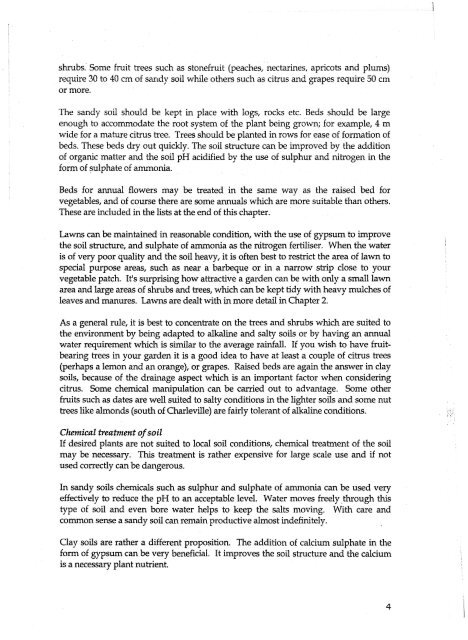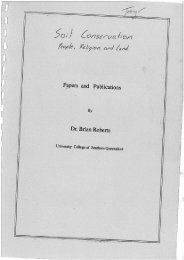western-queensland-gardening-guide.pdf - South West NRM
western-queensland-gardening-guide.pdf - South West NRM
western-queensland-gardening-guide.pdf - South West NRM
Create successful ePaper yourself
Turn your PDF publications into a flip-book with our unique Google optimized e-Paper software.
shrubs. Some fruit trees such as stonefruit (peaches, nectarines, apricots and plums)<br />
require 30 to 40 cm of sartdy soil while others such as citrus and grapes require 50 cm<br />
or more.<br />
The sandy soil should be kept in place with logs, rocks etc. Beds should be large<br />
enough to accommodate the root system of the plant being grown; for example, 4 m<br />
wide for a mature citrus tree. Trees should be planted in rows for ease of formation of<br />
beds. These beds dry out quickly. The soil structure can be improved by the addition<br />
of organic matter and the soil pH acidified by the use of sulphur and nitrogen in the<br />
form of sulphate of ammonia.<br />
Beds for annual flowers may be treated in the same way as the raised bed for<br />
vegetables, and of course there are some annuals which are more suitable than others.<br />
These are included in the lists at the end of this chapter.<br />
Lawns can be maintained in reasonable condition, with the use of gypsum to improve<br />
the soil structure, and sulphate of ammonia as the nitrogen fertiliser.<br />
is of very poor quality and the soil heavy, it is often best to restrict the area of lawn to<br />
special purpose areas, such as near a barbeque or in a narrow strip close to your<br />
vegetable patch. It's surprising how attractive a garden can be with only a small lawn<br />
area and large areas of shrubs and trees, which can be kept tidy with heavy mulches of<br />
leaves and manures. Lawns are dealt with in more detail in Chapter 2.<br />
As a general rule, it is best to concentrate on the trees and shrubs which are suited to<br />
the environment by being adapted to alkaline and salty soils or by having an annual<br />
water requirement which is similar to the average rainfall. If you wish to have fruitbearing<br />
trees in your garden it is a good idea to have at least a couple of citrus trees<br />
(perhaps a lemon and an orange), or grapes. Raised beds are again the answer in clay<br />
soils, because of the drainage aspect which is an important factor when considering<br />
citrus. Some chemical manipulation can be carried out to advantage. Some other<br />
fruits such as dates are well suited to salty conditions in the lighter soils and some nut<br />
trees like almonds (south of Charleville) are fairly tolerant of alkaline conditions.<br />
Chemical heatmmt of soil<br />
If desired plants are not suited to local soil conditions, chemical treatment of the soil<br />
may be necessary. This treatment is rather expensive for large scale use and if not<br />
used correctly can be dangerous.<br />
In sandy soils chemicals such as sulphur and sulphate of onia can be used very<br />
effectively to reduce the pH to an acceptable level. Water moves freely $through this<br />
type of soil and even bore water helps to keep the salts moving. With care and<br />
common sense a sandy soil can remain productive almost indefinitely.<br />
Clay soils are rather a different proposition. The addition of calcium sulphate in the<br />
form of gypsum can be very beneficial. It improves the soil structure and the calcium<br />
is a necessary plant nutrient.
















